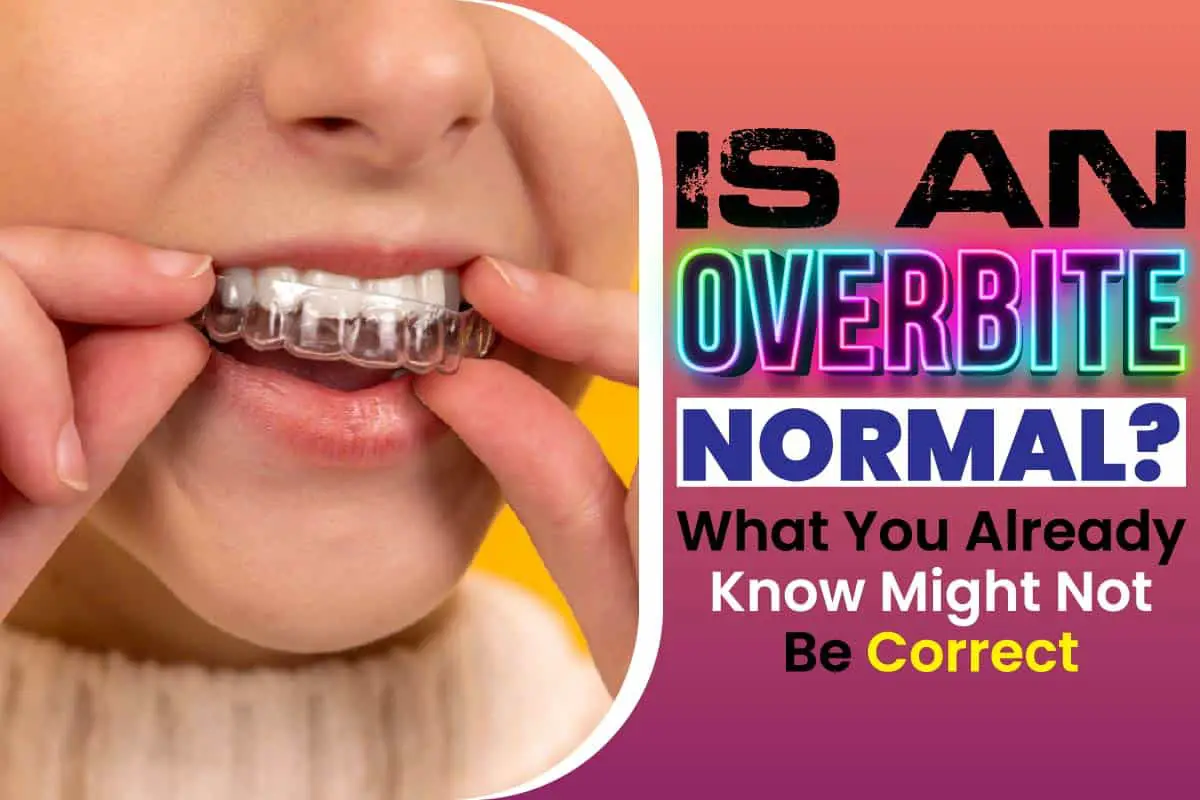Different dental conditions are known to man, and treatment is possible with proper orthodontic care.
Overbite is a common dental condition, and treatment depends on the severity of the overbite.
There are various types of overbites, and orthodontists devise unique means of treating each.
Studies have shown that overbite is one of the most common reasons people seek orthodontic treatment.
Now, check this out.
Is an overbite normal?
Overbites are normal when they are between 2 – 4 mm.
Many people have asked whether overbites are normal due to concerns about the functions and general appearance of the teeth, jaws, and mouth.
However, when an overbite is beyond 4 mm, it becomes an issue of concern. Getting orthodontic treatment becomes a necessity at this point.
Description Of An Overbite
The American Association of Orthodontists describes an overbite as a dental condition in which the upper front teeth overlap the lower front teeth while the jaw is closed.
The opposite of an overbite is an underbite.
On the other hand, an underbite is a condition in which the lower front teeth overlap the upper front teeth.
The treatment of an overbite is dependent on its severity and cause.
How Common Are Overbites?
On a norm, the upper teeth and lower teeth are supposed to align perfectly.
Therefore, not all individuals suffer from any form of teeth misalignment.
But in cases where overbite occurs, affected individuals ask whether the condition is normal or should be a cause of concern.
Well, overbite is one of the several common bite issues that people experience. It should only become a cause of concern when it exceeds the 4mm range.
Types Of Overbite
Generally, two types of overbites are known to man.
- Skeletal overbite: This condition occurs when the jaw bone develops abnormally, causing the teeth and jaws to grow disproportionately.
- Dental overbite: A dental overbite occurs when external factors interrupt dental development.
These external factors include loss of back teeth, crowding of teeth, and poor oral habits.
Severity of Overbite
An orthodontist determines the severity of overbite on a percentage scale based on the degree of overlap between the top and bottom.
Overbites could be 30%, 50% or 100%.
As the overbite percentage increases, its severity also increases, and treatment becomes more complex.
The most severe form of overbite is the impinging overbite.
Impinging overbite is a condition that occurs when the lower teeth touch the palate behind the upper teeth of a closed mouth.
If not properly managed, impinging overbite could lead to loss of the upper front teeth or cause serious trauma to the teeth.
Although patients may require oral surgery for severe overbite cases, you can treat the majority of overbites with proper orthodontic intervention.
Overbite Vs Overjet:
Often, people mistake overbite for overjet and vice versa. These two concepts are, however, distinct.
An overjet occurs when there is a horizontal gap between the top and bottom of the front teeth.
An overjet may not necessarily lead to an overbite.,However, people who have excessive overjet can also have an overbite.
Experienced orthodontists treat both conditions at the same time.
Problems of Untreated Overbite
A patient with an overbite diagnosis above 30% should seek the help of an orthodontist immediately.
When left untreated, overbites can lead to other health issues.
Some of these issues include:
- Speech impediment
- Trouble in chewing
- Breathing issues
- Damage to teeth and gums
- Pain while biting or chewing
- Change in facial appearance
The above-listed issues caused by untreated overbite are why you should see a specialist immediately.
Diagnosis of Overbite
For patients with bad habits like thumb sucking, nail-biting or pushing the teeth with their tongue, diagnosis of overbite or other associated bite problems is necessary.
However, early diagnosis of overbite is crucial as it helps patients get the best outcome from their treatment.
There are two methods to check for an overbite.
Home Diagnosis:
Home diagnosis is one way to diagnose overbite at an early stage.
Use the steps below to diagnose overbite at home.
Step 1: looking at the teeth in a mirror
- Stand in front of a mirror and keep your mouth and lips as close to the mirror as possible.
- Open your teeth by saying “E..” or just smiling. Remember not to do this forcefully.
- Inspect your teeth
Following the steps outlined above will lead you to either of the following conclusions.
Conclusion 1:
If you notice your teeth looks a bit unnatural, you have an excess overbite
Conclusion 2:
If your upper teeth overlap more than normal, you have a deep overbite.
Conclusion 3:
If your upper teeth protrude more forward than your lower teeth, you have an excessive overbite or deep bite.
Step 2: measurement of excess bite with a ruler
Having confirmed the presence of overbite, check for its severity and decide whether you should see an orthodontist or not.
- Take a small ruler and a mirror and touch your teeth together while being relaxed.
- Open your teeth
- Place the head of the ruler vertically on the outer surface of the lower teeth so that the ruler’s body touches the tip of the upper teeth.
The above-outlined steps give you the measurement of overjet or vertical overbite.
Step 3: complete your diagnosis
On completion of step 2, your measurement value will fall under one of the following classes of overbite.
Class 1:
If your horizontal overbite falls within the range of 2 to 3 mm, i.e. within the normal range, it falls under class one bite.
Class 2:
When overjet or overbite is more than 4mm, it is considered a class 2 case.
Orthodontist diagnosis:
Regular visits to a dentist will ensure the detection of an overbite. During routine checks, dentists usually search for them.
On detection of an overbite by a dentist, patients proceed to see an orthodontist.
For proper diagnosis of an overbite or other bite problems, the orthodontist performs the following techniques.
- Using measuring probe and thorough dental examination
- Taking a dental impression and making a mould
- Taking a dental x-ray
The orthodontist uses these methods to precisely diagnose an overbite and draw out a treatment plan.
Causes Of Overbites:
Overbites occur for several reasons.
1. Genetics:
We refer to overbites caused by genetics as skeletal overbites. They arise from irregular growth of the jawbone structure.
The development and shape of bones result from genes inherited from members of one’s family.
2. Overcrowding:
A major cause of overbite is overcrowding as the teeth fight for positions in the mouth.
Different reasons often lead to crowding.
Teeth loss resulting from wear and tear can lead to crowding of the remaining teeth, which can cause overbite.
3. External factors:
Some external factors like thumb sucking or prolonged use of pacifiers can lead to an overbite.
Bad habits like biting nails or chewing the ends of pencils or ponytails can also cause overbite.
Treatment Of Overbites:
After a diagnosis of overbite by a certified orthodontist, treatment is the usual step that comes next.
Treatment of overbites includes the use of:
Dental braces:
Used mainly to fix crooked and misaligned teeth, you can also use dental braces to fix overbites.
Step 1:
Attach braces to straighten and align the teeth.
You can use braces with approval from your orthodontist.
Step 2:
Upon completion of teeth alignment, you can place elastic bands on the brackets of the teeth.
The constant pressure applied to the elastic bands ensures that the jaws shift into their correct position.
You must remove elastic bands before drinking, eating or even brushing your teeth.
Step 3:
This step is the final stage, and it involves wearing a retainer to keep the teeth in the correct position.
Although the period of correcting overbites varies from patient to patient, using braces to correct severe cases can take a minimum of 2 years.
2. Invisalign:
Invisalign is a more viable option compared to the use of braces
Patients uncomfortable with the change in appearance that comes with braces can make use of Invisalign.
Correcting overbite with Invisalign includes a series of clear trays that ensure the patient’s teeth mould into their correct positions.
With time, patients, based on suggestions from their orthodontist, switch to different trays and overbite is eventually corrected completely.
Although more expensive than regular braces, Invisalign is better for its shorter correction time.
Depending on the severity of the overbite, Invisalign can correct this condition within a minimum of one year.
3. Surgery:
In cases of misaligned jawbones, the correction will require surgery.
However, overbite surgery is only ideal for adults as it is not necessary for children.
Using braces or Invisalign is better for correcting overbite cases in children as their teeth and bones are still undergoing development.
Conclusion
Overbite is a common dental condition and is normal when it is within the range of 2 to 4 mm.
However, when it exceeds the 4 mm range, it becomes necessary to seek treatment. If left untreated, problems may arise.
Early diagnosis and treatment can help prevent or even completely fix an overbite.
The best time to treat overbite in children is within the ages of 10 to 12.
The use of dental braces and Invisalign are common methods for treating overbites.
You May Like These Articles As Well:
What To Do When Your Urine Smells Like Ham
Similarities And Differences Between Chinese Vs Japanese Culture
Why Am I Stressed For No Reason: 6 Shocking Reasons And Solutions
 Being Human
Being Human




